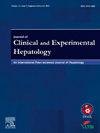Banding Down the Hurdles: Evaluating Endoscopic Variceal Ligation for Rectal Varices
IF 3.3
Q2 GASTROENTEROLOGY & HEPATOLOGY
Journal of Clinical and Experimental Hepatology
Pub Date : 2025-01-06
DOI:10.1016/j.jceh.2024.102499
引用次数: 0
Abstract
Portal hypertension can lead to the formation of rectal varices. Rectal varices are a common manifestation of portal hypertension but tend to bleed less frequently than esophageal or gastric varices. It has been observed that rectal varices can result in significant lower gastrointestinal (GI) bleeding and pose unique therapeutic challenges. This case series evaluates the efficacy and safety of endoscopic variceal ligation (EVL) in treating rectal varices in five patients who presented with lower GI hemorrhage to our center. While Endoscopic Ultrasound (EUS) or Computed Tomography (CT) could provide additional diagnostic insights, these modalities were not routinely used in this series because of the straightforward clinical and endoscopic diagnosis. All patients underwent a successful EVL procedure with complete variceal obliteration. There were no postprocedural complications noted. Six months after the initial course of treatment, a follow-up endoscopy was performed. Overall, one patient required three sessions of EVL, whereas two other patients needed two more sessions. None of the patients had any residual varices at the 5-year follow-up. These findings demonstrate that EVL is an effective treatment modality for rectal varices, particularly in resource-constrained environments. Ongoing endoscopic surveillance is crucial because recurrence is a possibility as seen in many studies. Although our results lend support to the use of EVL, more studies with larger patient populations and longer periods of follow-up are required to validate these findings and improve treatment regimens.

消除障碍:评估内镜下直肠静脉曲张结扎术
门静脉高压可导致直肠静脉曲张的形成。直肠静脉曲张是门静脉高压的常见表现,但出血的频率低于食管或胃静脉曲张。据观察,直肠静脉曲张可导致显著的下消化道出血,并提出独特的治疗挑战。本病例系列评估内镜下静脉曲张结扎(EVL)治疗直肠静脉曲张的有效性和安全性,其中5例患者表现为下消化道出血。虽然内窥镜超声(EUS)或计算机断层扫描(CT)可以提供额外的诊断见解,但由于临床和内窥镜诊断直接,这些方式在本系列中并未常规使用。所有患者均成功行EVL手术,静脉曲张完全闭塞。无术后并发症。初次治疗6个月后,进行随访内窥镜检查。总体而言,一名患者需要三次EVL,而另外两名患者需要两次以上的EVL。在5年的随访中,没有患者有任何残留的静脉曲张。这些发现表明EVL是直肠静脉曲张的有效治疗方式,特别是在资源受限的环境中。持续的内窥镜监测是至关重要的,因为在许多研究中发现复发是可能的。虽然我们的研究结果支持EVL的使用,但需要更多的研究和更大的患者群体和更长的随访时间来验证这些发现并改进治疗方案。
本文章由计算机程序翻译,如有差异,请以英文原文为准。
求助全文
约1分钟内获得全文
求助全文
来源期刊

Journal of Clinical and Experimental Hepatology
GASTROENTEROLOGY & HEPATOLOGY-
CiteScore
4.90
自引率
16.70%
发文量
537
审稿时长
64 days
 求助内容:
求助内容: 应助结果提醒方式:
应助结果提醒方式:


